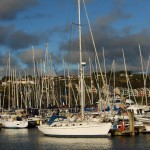Cork City (Ireland)
Cork City (Irish: Corcaigh—from corcach meaning “swamp”) is the second largest city in the Republic of Ireland and the island of Ireland’s third most populous city after Dublin and Belfast. The city is situated on the southern coast on the territory that is away from the sea, but it is connected to the sea by the narrow Passage West channel.
The city is built on the River Lee which divides into two channels at the western end of the city. The city centre is located on the island created by the channels. At the eastern end of the city centre they converge; and the Lee flows around Lough Mahon to Cork Harbour, one of the world’s largest natural harbours. The city is a major Irish seaport; there are quays and docks along the banks of the Lee on the city’s east side.
Cork is the intellectual center of southern Ireland; there are many cultural institutions here, among which are Literature and Science Associations of Cork established in 1820. In the city there are also the College of the National University of Ireland and two cathedrals – one Catholic and one Protestant.
Cork’s deep harbour allows ships of any size to enter, bringing trade and easy import/export of products.
Cork was originally a monastic settlement founded by Saint Finbarr in the 6th century on a small island on the River Lee. The monastery and the settlement that grew and thrived near its walls in spite of the raids of the Danes later formed a fortified complex. After English King Henry II arrived in Ireland in 1172 the city was captured, ruined and restored several times. Cork changed hands while its rulers came and went. In 1284 it was surrounded by a new wall; in 1378 it was reduced to ashes by the Irish; in 1495 the city was seized by Perkin Warbeck, a pretender to the English throne from the House of York. In 1642 the castle was seized by Irish rebels who were driven out of the city in 1644. In 1690 all the city walls were torn down.
During the Civil War in 1920 two Mayors of the city were killed and large areas were damaged by fire.
As a result of this course of history of wars and destructions, almost no old buildings remained in Cork. However, several buildings of XVIII century can still be found here, and the center of the city located between the two channels of the River Lee still looks as it looked like in the beginning of XIX century. The facades of the houses in the city are painted in white, while the embankments of the channels are planted with trees.

